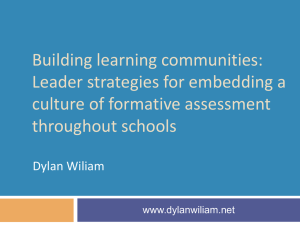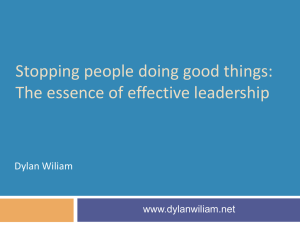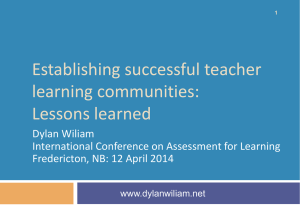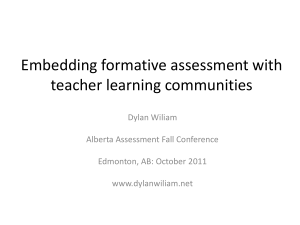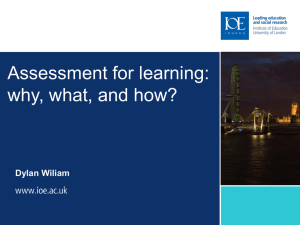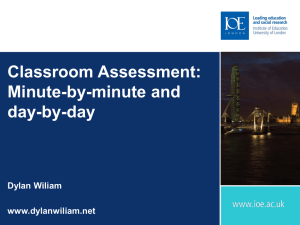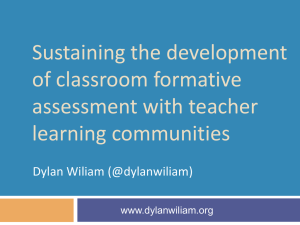SSAT 2012 breakout
advertisement
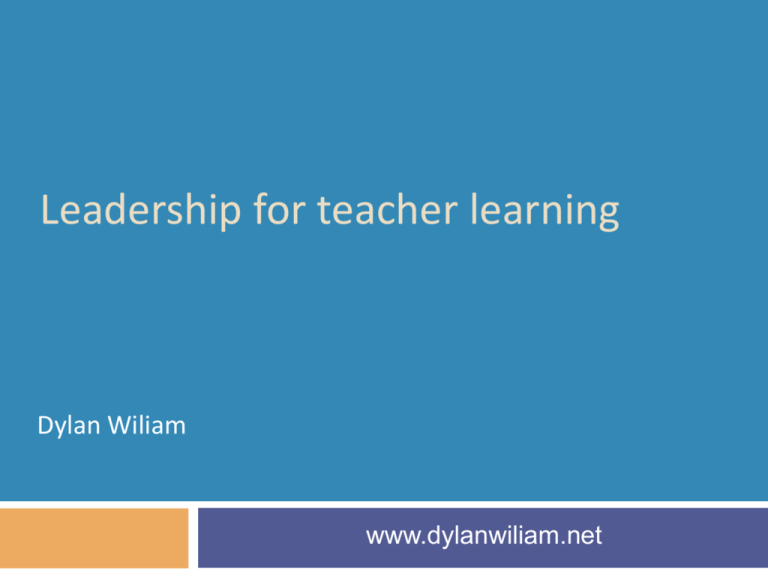
Leadership for teacher learning Dylan Wiliam www.dylanwiliam.net Before we begin… 2 Slides available at www.dylanwiliam.org Twitter @dylanwiliam Today #ssatnc12 Control and impact 3 Control Inside Outside Low Brain gym Learning styles High Formative assessment Poverty alleviation Class size reduction Impact Unpacking formative assessment 4 Where the learner is going Teacher Peer Learner Clarifying, sharing and understanding learning intentions Where the learner is How to get there Providing Engineering effective discussions, tasks, and feedback that moves learners activities that elicit forward evidence of learning Activating students as learning resources for one another Activating students as owners of their own learning And one big idea 5 Where the learner is going Teacher Peer Learner Where the learner is How to get there Using evidence of achievement to adapt what happens in classrooms to meet learner needs The knowing-doing gap (Pfeffer 2000) 6 Statement We know we should do this We are doing this Getting good ideas from other units in the chain 4.9 4.0 Instituting an active suggestions program 4.8 3.9 Using a detailed assessment process for new hires 5.0 4.2 Posting all jobs internally 4.2 3.5 Talking openly about learning from mistakes 4.9 4.3 Providing employees with frequent feedback 5.7 5.2 Sharing information about financial performance 4.3 3.8 The happiness hypothesis (Haidt, 2005) + – The rider Rational Good at complex analysis Focused on the long-term Thinks about the future Weak Easily distracted Gets bogged down in detail Tires quickly The elephant Instinctive Compassionate Sympathetic Loyal Protective Powerful Emotional Skittish Focused on the short-term Thinks about the present Strategies for change (Heath & Heath, 2010) Direct the rider Follow the bright spots Script the critical moves Point to the destination Motivate the elephant Find the feeling Shrink the change Grow your people Shape the path Tweak the environment Build habits Rally the herd Professional learning communities 9 Why people shouldn’t work on their own 10 Only 2% of high school seniors believe their leadership skills are below average (College Board, 1976/1977) …and 25% of them believe they are in the top 1% in their ability to get along with others (College Board, 1976/1977) 93% of Americans and 69% of Swedes think they are above average drivers (Svenson, 1981) 94% of college professors report doing above average work (Cross, 1997) People think they are at lower risk than their peers for heart attacks, cancer, food poisoning, etc. (Weinstein, 1980) Strangers predict your IQ better than you do (Borkenau & Liebler, 1993) People believe they are more accurate than their peers at self-assessment (Pronin, Lin, & Ross, 2002) Collaboration and creativity in ‘small worlds’ Analysis of all 442 musicals on Broadway from 1945 to 1989 105 hits (generated enough cash to cover costs) 288 flops (did not generate enough cash to cover costs) 49 failures (did not open) For each show, the “core team” consisted of composer lyricist librettist choreographer director producer Defining the closeness of a team 12 For each musical, the following measures were derived Cluster coefficient (CC): the average fraction of a member’s collaborators who have collaborated previously (high value indicates a core team who have worked together a lot) Path length (PL): the average number of intermediaries between members of the core team (a high value indicates that members do not have many collaborators in common) Small world quotient (Q): the ratio of CC to PL (a high value indicates a core team that have worked together a lot and have collaborators in common) Probability of a Broadway hit: 1945-1989 50% 40% 30% 20% 10% 0% 1.0 1.5 2.0 2.5 Small world quotient (Q) Uzzi and Spiro (2005) 3.0 3.5 Professional learning communities 14 Professional Decision-making under uncertainty Accountable to a community of peers Learning Focused on improvement in student outcomes Communities Joint enterprise Mutual engagement Shared repertoire Main approaches to formative assessment Professional Learning Communities “…an inclusive group of people, motivated by a shared learning vision, who support and work with each other, finding ways, inside and outside their immediate community, to enquire on their practice and together learn new and better approaches that will enhance all pupils’ learning.” (Stoll et al., 2006) Two main foci Student achievement (PLCs) Teacher expertise (TLCs) Complementary processes 16 Student achievement Quality control Common assessments Improvement through better team work and systems Focus on individual outcomes for students Regular meetings focused on data 16 points on PISA (in two to three years) Teacher expertise Quality assurance Highly structured meetings Improvement through increased teacher capacity Focus on teachers’ individual accountability for change Regular meetings focused on teacher change 30 points on PISA (in two to three years) A model for teacher learning 17 Content, then process Content (what we want teachers to change): Evidence Ideas (strategies and techniques) Process (how to go about change): Choice Flexibility Small steps Accountability Support A model for teacher learning 18 Content, then process Content (what we want teachers to change): Evidence Ideas (strategies and techniques) Process (how to go about change): Choice Flexibility Small steps Accountability Support Choice A strengths-based approach to change 20 Belbin inventory (Management teams: Why they succeed or fail): Eight team roles (defined as “a tendency to behave, contribute and interrelate with others in a particular way”): Key ideas: Company worker; innovator; shaper; chairperson; resource investigator; monitor/evaluator; completer/finisher; team worker Each role has strengths and allowable weaknesses. People rarely sustain “out-of-role” behavior, especially under stress. Each teacher’s personal approach to teaching is similar: Some teachers’ weaknesses require immediate attention. For most, however, students benefit more from the development of teachers’ strengths. Flexibility Strategies and techniques 22 Distinguish between strategies and techniques: Strategies define the territory of formative assessment (no-brainers). Teachers are responsible for choice of techniques: Allows for customization; caters for local context Creates ownership; shares responsibility Key requirements of techniques: They embody the deep cognitive and affective principles that research shows are important. They are seen as relevant, feasible, and acceptable. Context matters… 23 This version of the posture requires considerable strength in the neck, shoulders and back, requiring years of practice to achieve. It should not be attempted without supervision. 24 Tight, but loose 25 Two opposing factors in any school reform Need for flexibility to adapt to local constraints and affordances Need to maintain fidelity to the theory of action of the reform, to minimise “lethal mutations” Implies there is appropriate flexibility built into the reform So you have to have a clearly articulated theory of action Different innovations have different approaches to flexibility Some reforms are too loose (e.g., ‘Effective schools’ movement) Others are too tight (e.g., Montessori Schools) The “tight but loose” formulation: … combines an obsessive adherence to central design principles (the “tight” part) with accommodations to the needs, resources, constraints, and affordances that occur in any school or district Design and intervention 26 Our design process cognitive/affective insights synergy/ comprehensiveness set of components Teachers’ implementation process set of components synergy/ comprehensiveness cognitive/affective insights Small steps Expertise 28 According to Berliner (1994), experts: Excel mainly in their own domain Often develop automaticity for the repetitive operations that are needed to accomplish their goals Are more sensitive to the task demands and social situation when solving problems Are more opportunistic and flexible in their teaching than novices Represent problems in qualitatively different ways than novices Have faster and more accurate pattern recognition capabilities Perceive meaningful patterns in the domain in which they are experienced Begin to solve problems slower but bring richer and more personal sources of information to bear Knowing more than we can say 29 Six video extracts of a person delivering cardiopulmonary resuscitation (CPR): Five of the video extracts feature students. One of the video extracts feature an expert. Videos shown to three groups students, experts, instructors Success rate in identifying the expert: Experts: 90% Students: 50% Instructors: 30% Klein and Klein (1981) Knowledge creation and conversion 30 to Explicit knowledge Tacit knowledge Dialogue Tacit knowledge from Explicit knowledge Socialization Externalization sympathised knowledge conceptual knowledge Networking Sharing experience Internalization Combination operational knowledge systemic knowledge Learning by doing Nonaka and Takeuchi (1995) Looking at the wrong knowledge 31 The most powerful teacher knowledge is not explicit: That’s why telling teachers what to do doesn’t work. What we know is more than we can say. And that is why most professional development has been relatively ineffective. Improving practice involves changing habits, not adding knowledge: That’s why it’s hard: And the hardest bit is not getting new ideas into people’s heads. It’s getting the old ones out. That’s why it takes time. But it doesn’t happen naturally: If it did, the most experienced teachers would be the most productive, and that’s not true (Hanushek & Rivkin, 2006). 32 33 Sensory capacity 34 Sensory system Total bandwidth (in bits/second) Conscious bandwidth (in bits/second) Eyes 10,000,000 40 Ears 100,000 30 Skin 1,000,000 5 Taste 1,000 1 Smell 100,000 1 Nørretranders (1998) Hand hygiene in hospitals Study Preston, Larson, & Stamm (1981) Focus Compliance rate Open ward 16% ICU 30% Albert & Condie (1981) ICU 28% to 41% Larson (1983) All wards 45% Donowitz (1987) Pediatric ICU 30% Graham (1990) ICU 32% Dubbert (1990) ICU 81% Pettinger & Nettleman (1991) Surgical ICU 51% Larson, et al. (1992) Neonatal ICU 29% Doebbeling, et al. (1992) ICU 40% Zimakoff, et al. (1992) ICU 40% Meengs, et al. (1994) ER (Casualty) 32% Pittet, Mourouga, & Perneger (1999) All wards 48% ICU 36% Pittet (2001) Accountability Making a commitment 37 Action planning: Forces teachers to make their ideas concrete and creates a record Makes the teachers accountable for doing what they promised Requires each teacher to focus on a small number of changes Requires the teachers to identify what they will give up or reduce A good action plan: Does not try to change everything at once Spells out specific changes in teaching practice Relates to the five “key strategies” of AFL Is achievable within a reasonable period of time Identifies something that the teacher will no longer do or will do less of And being held to it 38 “I think specifically what was helpful was the ridiculous NCR [No Carbon Required] forms. I thought that was the dumbest thing, but I’m sitting with my friends and on the NCR form I write down what I am going to do next month. “Well, it turns out to be a sort of ‘I’m telling my friends I’m going to do this’ and I really actually did it and it was because of that. It was because I wrote it down. “I was surprised at how strong an incentive that was to do actually do something different…that idea of writing down what you are going to do and then because when they come by the next month you better take out that piece of paper and say ‘Did I do that?’…just the idea of sitting in a group, working out something, and making a commitment…I was impressed about how that actually made me do stuff.” —Tim, Spruce Central High School Support Supportive accountability 40 What is needed from teachers: A commitment to: The continual improvement of practice Focus on those things that make a difference to students What is needed from leaders: A commitment to engineer effective learning environments for teachers by: Creating expectations for continually improving practice Keeping the focus on the things that make a difference to students Providing the time, space, dispensation, and support for innovation Supporting risk-taking A case study in risk 41 Transposition of the great arteries (TGA) A rare, but extremely serious, congenital condition in newborn babies (~25 per 100,000 live births) in which Traditional treatment—the ‘Senning’ procedure which involves: the aorta emerges from the right ventricle and so receives oxygenpoor blood, which is carried back to the body without receiving more oxygen the pulmonary artery emerges from the left ventricle and so receives the oxygen-rich blood, which is carried back to the lungs Creating a ‘tunnel’ between the ventricles, and Inserting a ‘baffle’ to divert oxygen-rich blood from the left ventricle (where it shouldn’t be) to the right ventricle (where it should) Prognosis Early death rate (first 30 days): 12% Life expectancy: 46.6 years The introduction of the ‘switch’ procedure Senning Number of early deaths 60 Transitional Switch 50 40 30 20 Life expectancy: 10 Senning procedure: 47 years Switch procedure: 63 years 0 0 50 100 150 200 250 Number of procedures carried out 300 Teacher learning communities 43 44 We need to create time and space for teachers to reflect on their practice in a structured way, and to learn from mistakes. (Bransford, Brown & Cocking, 1999) “Always make new mistakes.” —Esther Dyson “Ever tried. Ever failed. No matter. Try again. Fail again. Fail better.” (Beckett, 1984) Strategies for teacher change 45 Direct the rider Follow the bright spots (volunteers vs. conscripts) Script the critical moves (structured meetings) Point to the destination (all students can succeed) Motivate the elephant Find the feeling (the moral imperative) Shrink the change (small steps) Grow your people (all teachers can improve) Shape the path Tweak the environment (time for teacher learning) Build habits (create routines and structures) Rally the herd (make new mistakes) Teacher learning communities 46 Plan that the TLC will run for two years. Identify 10 to 12 interested colleagues: Composition: Similar assignments (e.g., early years, math/science) Mixed subject/mixed phase Hybrid Secure institutional support for: Monthly meetings (75–120 minutes each, inside or outside school time) Time between meetings (two hours per month in school time): Collaborative planning Peer observation Any necessary waivers from school policies Signature pedagogies 47 In Law 48 In Medicine 49 A “signature pedagogy” for teacher learning 50 Every monthly TLC meeting should follow the same structure and sequence of activities: Activity 1: Introduction (5 minutes) Activity 2: Starter activity (5 minutes) Activity 3: Feedback (25–50 minutes) Activity 4: New learning about formative assessment (20–40 minutes) Activity 5: Personal action planning (15 minutes) Activity 6: Review of learning (5 minutes) Activities 1, 2, 3, 5, 6: “Bookends” 51 For each of these five activities, the process is exactly the same at each TLC meeting This provides a familiar structure for teachers to get better together As the structure fades into the background, The learning comes into the foreground Teachers come to the meeting knowing what is expected of them Ground-rules for TLCs 52 Norms of collaboration (Garmston & Wellman, 1999) Seven powerful Ps Pausing Paraphrasing Probing Putting ideas on the table (and pulling them off!) Paying attention to self and others Presuming positive intentions Pursuing a balance between advocacy and inquiry Activity 1: Introduction 53 Sharing learning intentions for the meeting Activity 2: Starter 54 A variety of warm-up activities to get participants’ minds to the meeting: Think of something you are looking forward to this year 30-seconds to get “things off your chest” about what infuriates you about your job 30 seconds to tell the group about something that happened within the last month and made you feel good Think of something that happened in a lesson this year that made you smile Think of something that one of your colleagues did last term that supported you Go back to the TLC ‘ground rules’ Activity 3: Feedback 55 Routines need to be established, expectations shared, and structure maintained. Similar expectations regarding preparation and engagement. Come to the meeting knowing you will be sharing your own AfL experiences. Be prepared to offer constructive, thoughtfully conceived feedback to colleagues. Be prepared to challenge ideas that may be good classroom practice but are not necessarily tightly related to formative assessment. Activity 4: New learning about AfL 56 Drip-feed’ of new ideas, to increase knowledge, and to produce variety Watch videos of classroom practice Book study (one chapter each month) New AfL techniques Activity 5: Personal action planning 57 Each teacher updates his or her personal action plan Makes a specific commitment about what they will do over the coming month Arranges any support needed from colleagues Specific date and time for peer observation Activity 6: Wrap 58 Did the meeting meet its intended objectives If yes, great If no, time to plan what to do about it Every TLC needs a leader 59 The job of the TLC leader(s): To ensure that all necessary resources (including refreshments!) are available at meetings To ensure that the agenda is followed To maintain a collegial and supportive environment But most important of all: It is not to be the formative assessment “expert.” Every TLC needs a leader 60 The job of the TLC leader(s): To ensure that all necessary resources (including refreshments!) are available at meetings To ensure that the agenda is followed To maintain a collegial and supportive environment But most important of all: It is not to be the formative assessment “expert.” Membership of TLCs 61 Volunteers Conscripts Benefits Risks Culture deepens quickly Treated as “additional” than “core” Appealing to ‘keen’ teachers Non-volunteers left behind Oppositional sub-culture less likely ‘Project mentality’ disconnected from practice Differences in approach can Tokenistic adoption be used to deepen conversations Peer observation 62 Run to the agenda of the observed, not the observer: Observed E.g., teacher specifies focus of observation: teacher wants to increase wait time. Observed Provides Observed teacher specifies what counts as evidence: observer with a stopwatch to log wait times. teacher owns any notes made during the observation. A hinge-point question about TLC leaders 63 What is the most important role of the TLC leader? A. Becoming the most knowledgeable about AfL in your school B. Reserving the room, making the handouts, and organizing refreshments C. Making sure the TLC meeting occurs and has good attendance D. Recruiting as many new teachers as possible to join the TLC E. Making sure the meeting keeps a strong AfL focus and that everyone shares/gets support A hinge-point question about TLC meetings 64 What is the most important purpose of a TLC meeting? A. Giving teachers who may not know each other well a chance to work together B. Learning new AfL techniques that can be used in your classroom C. Learning new AfL techniques in order to keep the meetings fresh D. Reporting what AfL technique(s) you have tried and getting help where you are stumped E. Planning what AfL technique(s) you are going to try next in your classroom Making time to “sharpen the saw” A case study in one district 66 Cannington Urban school district serving ~20,000 students Approximately 20% of the population non-white No schools under threat of re-constitution, but all under pressure to improve test scores Funding for a project on “better learning through smarter teaching” Focus on mathematics, science and modern foreign languages (MFL) Commitment from Principals in November 2007 Initial workshops in July 2008 Progress of TLCs in Cannington 67 Maths Science MFL Ash 1 — 1 — 0 — Cedar 5 ▮ 1 ▮ 3 ▮▮ Hawthorne 4 ▮▮ 10 ▮ ▮ 5 ▮▮▮▮ Hazel 7 — 12 — 2 — Larch 1 ▮▮▮▮ 0 ▮ 0 ▮ Mallow 6 ▮▮▮ 7 ▮ 3 ▮▮ 3 ▮▮▮ 1 ▮▮▮ Poplar 11 ▮ Spruce 7 ▮▮▮▮ 8 ▮▮▮ 5 ▮▮▮ Willow 2 ▮ 5 ▮ 2 ▮▮▮▮ Totals 44 47 21 Black nos. show teachers attending launch event; blue bars show progress of TLC Cake or death? 68 How will we know if it’s working? 69 Monitoring implementation 70 Evidence is expensive to collect, so it is important to make sure evidence is used well There is therefore an imperative to use the same evidence for as many uses as possible This is wrong Multiple uses of the same evidence distort the data, and in particular… …summative drives out formative Mapping out the terrain 71 Timescale Annual Interim Weekly Daily Hourly Academic promotion Benchmark Common formative assessments Before the endof-unit tests Exit pass End-of-course exams High-stakes accountability Growth End-ofunit tests Hinge-point questions Instructional Guidance (“formative”) Describing Individuals (“summative”) Function Institutional Accountability (“evaluative”) We’ll know when it’s working when… 72 Leading indicators of success Teachers are given time to meet, and do so Teachers increasingly act as “critical friends” to others The prevalence of classroom formative assessment practices is increasing Students are more engaged in classrooms Teachers modify the techniques in appropriate ways, indicating an understanding of the underlying theory There is a shift in the ownership of the reform Lagging indicators of success Increased student achievement Possible foci for “Learning walks” 73 Foci Clear, valuable learning intentions for lesson Success criteria understood by students Students chosen at random Questions that make students think Students, not teacher, dominate discussions At least 80% students involved in answering questions All-student response system used Teacher waits three seconds after question Students support each others’ learning Students take responsibility for own learning Teacher gives oral formative feedback Evidence of comments that advance learning Teacher finds out what students learned Teaching adjusted after data collection Rating Exemplary practice Good practice Seen, but weak Non-existent Used inappropriately When is change sustainable? 74 Understanding what it means to scale (Coburn, 2003) Depth Sustainability Spread Shift in reform ownership Consideration of the diversity of contexts of application Clarity about components, and the theory of action Key stakeholders’ reactions 75 Departmental sub-cultures Unions Professional associations Teaching assistants Parents Governors Community leaders Managing disappointments 76 Failure: opportunity for learning or blame Falling down: failing or learning? High-reliability organizations embrace failure $1m dollar club “A complaint is a gift” Group-work is hard for teachers, … and for teachers of teachers… Force-field analysis (Lewin, 1954) 77 What are the forces that will support or drive the adoption of formative assessment practices in your school/authority? + What are the forces that will constrain or prevent the adoption of formative assessment practices in your school/authority? — Summary 78 To be effective, teacher professional development must address: What teachers do in the classroom How teachers change what they do in the classroom Formative assessment + teacher learning communities: A point of (uniquely?) high leverage To find out more… Slides (and much else) available from www.dylanwiliam.org
